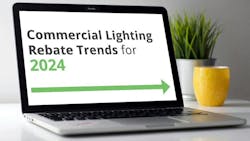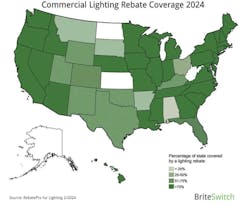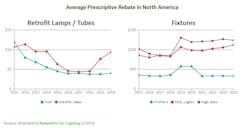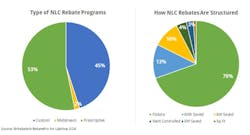According to BriteSwitch, a firm specializing in capturing local, utility, state, and federal rebates/incentives for businesses, the past couple of months have seen a flurry of activity as organizations updated their rebate programs for 2024. Each year, these incentives, which have been instrumental in driving energy efficiency since the mid-80s, continue to evolve to reflect the changing industry and market dynamics. Now, the dust has settled, and most of the new programs have launched, and it's very favorable for those in the lighting industry.
Here are the rebate trends for commercial lighting and control rebates in 2024.
Most of U.S. has a commercial lighting rebate program available
Over the last 15 years, the availability of commercial lighting rebate programs across the United States has been subject to fluctuations. In that time, the portion of the country covered by a lighting incentive varied between 42% to 79%. However, recent years have seen a welcome trend towards stability.
This year, 78% of the country boasts access to such a program (see Map below). It’s the fourth year in a row we’ve seen this coverage level, a good sign for distributors and contractors who rely on these rebate programs to help close business.
However, that doesn’t mean everything stayed the same. For example, some utilities in Ohio debuted new programs in mid-2023. Until that point, the state had no rebate opportunity due to legislation that stopped the energy efficiency rebate programs in Ohio in 2020.
Generally speaking, the Northeast and Northwest remain the best areas with the strongest incentives and good coverage. States like North Dakota and Kansas remain holdouts with no commercial lighting programs at all. The states with the highest populations, California, Florida, and Texas, still have some of the worst rebate opportunities with very few programs which are usually very complex.
Rebate amounts for LEDs still strong
When LEDs were first introduced in rebate programs, the amounts were very high, but quickly, a pattern emerged where the rebate amounts declined every year by 10% to 20%. It was a disturbing trend that had many wondering if it was a race to the bottom.
In 2021, that all turned around. Between the soft market, due to a lack of demand for projects and cost increases, the rebate decline slowed down. The incentives started to level out, and over the past few years, we’ve noticed relative stability (Fig. 1).
In fact, rebate amounts for 2024 are up 2% on average for LEDs and 5% for controls. For most LED products, the average rebate across North America is near the highest recorded levels.
The best rebates are still for LED fixtures replacing HID fixtures like high bays and pole lights. It makes sense since these fixtures typically cost the most and also offer the highest energy savings (Fig. 2).
With the changes from EISA that went into effect in July 2023, it was expected that the rebate amounts for A19s, PARs, and downlights would decrease significantly, but to everyone’s surprise, they increased. While many programs like Duke Energy’s Smart Saver Program, Energizing Connecticut’s Instant Lighting Program, and the state-wide MassSave program discontinued rebates for these types of lamps, many other programs still continue to include them in their offerings at a higher average dollar amount.
Program funding stretches further
The volatility of commercial lighting rebate programs makes it more challenging for contractors, manufacturers, and lighting distributors to take advantage of. Historically, one of the big issues has been programs running out of funding before the program year is over. According to RebatePro for Lighting, 10 - 25% of programs would traditionally run out of funding before the year ended.
However, recent trends indicate a shift toward sustained funding. In 2023, less than 5% of programs ran out of funding before year end. In the late fall, when programs would typically announce their lack of funding, the announcements instead focused on bonus programs. These limited-time spiffs offered increases of 10% to100% for some of the most common upgrades.
By the end of 2023, 22% of the programs provided some type of bonus. Some of these bonus programs have even continued into 2024. Right now, more than 30 different bonus or trade ally programs are running, which is quite uncommon to see in the first quarter. One example is Georgia Power’s program, which is is offering a 50% bonus on all standard rebates through June 30.
These changes are most likely not because of increased overall funding levels but decreased participation. With the lighting retrofit market slowing down — and most of the easy targets already having upgraded to efficient lighting, the remaining holdouts will take more convincing. At the same time, contractors and distributors are turning their attention to other opportunities, looking at more attractive and rapidly growing markets like EV chargers and battery storage/backup. Higher incentives are needed if programs are going to meet their annual energy savings goals.
Networked lighting control (NRC) rebates get a bit stronger
There’s been a lot of talk in the lighting industry about the savings potential of networked lighting controls (NLCs). While lighting has become more efficient over the years, turning it off altogether — or offering just the right amount of light when needed — offers even more energy savings. But NLC’s extra cost and complexity make them a tougher sell for many contractors and distributors. Thankfully, this year sees some improvement in the structure, availability and amounts of NLC incentives.
In 2024, 8% more utilities are offering a rebate specifically for NLCs. That means a majority of rebate programs in the United States have now written these controls specifically into their programs. For the other programs, NLC projects will typically qualify under a performance or custom program.
The type of NLC rebate has also shifted, with 53% of rebates being prescriptive — up from 44% last year (Fig. 3). Additionally, standardization of NLC incentives has increased. This year, 70% of the NLC rebates are now paid per fixture, rather than the more complex calculations like kilowatt-hour saved, square feet, or connected watt (Fig. 4).
In terms of dollar amounts, the average NLC rebate amount increased by 4% over 2023.
Don't overlook commercial lighting rebates this year
With a softer market for commercial lighting retrofits and many in the channel looking to diversify their interests in other markets, rebates are increasingly important. Incentive programs are more stable than ever — with near record-high dollar amounts. Millions of dollars in incentives are out there and available. For every project, you should look into the potential rebates and see how they will impact the payback of the upgrade.
About the Author
Randy Young
Director of Marketing and Data Solutions
Randy Young is the director of marketing and data solutions at BriteSwitch, a company that specializes in finding and capturing rebates for businesses. He can be reached at [email protected].




